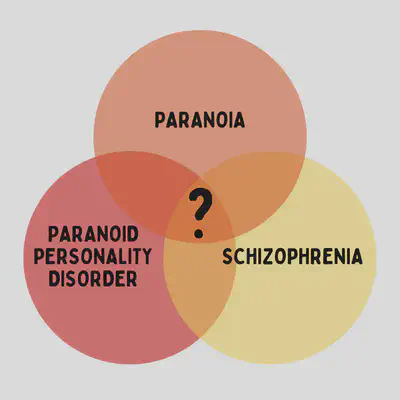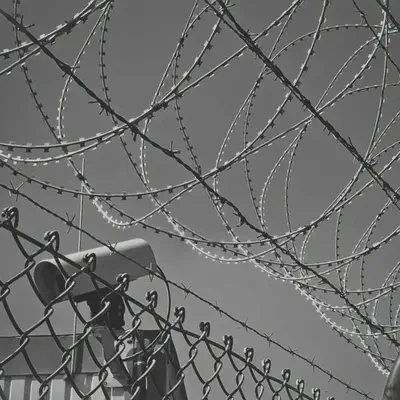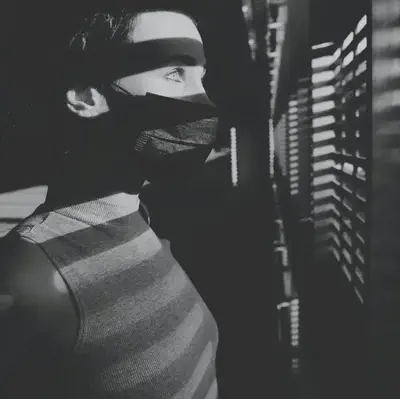Parsing out Paranoia, Paranoid Personality, and Paranoid Schizophrenia
How do paranoia, paranoid personality disorder, and paranoid schizophrenia (which no longer exists) overlap? Where’s the line between personality pathology and psychosis? Are paranoid personalities schizophrenic? Can they develop it? There are many paranoia/d labels and criteria spanning a range of diagnoses. Let’s unpack all this confusing stuff!

What are Delusions?
To understand paranoia, we actually need to discuss delusions first, because delusions are part of paranoia. Also, our current Delusional Disorders were formerly called Paranoid Disorder, so that makes it confusing as well as relevant. According to the DSM1, delusions are “fixed beliefs that are not amenable to change in light of conflicting evidence,” which also means that they have emotional significance to the belief-holder. Delusions can be both far-fetched (bizarre delusion) or non-bizarre. They can be coherent, consistent, and organized (systematized delusion), sometimes even being interconnected (delusional system), or they can be disorganized, inconsistent, and illogical (fragmentary delusion).
Delusional content can be related to the self/personality (autopsychic delusion), others/the world (allopsychic delusion), and/or one’s own body (somatic/somatopsychic delusion). However, delusions don’t neatly fall into categories. For example, delusions of influence can be both about the self and about others, and paranoid delusions can include elements of persecution, jealousy, and grandeur.
- Delusions about the self can involve erotic delusions (“Justin Bieber is in love with me”); delusions of reference (“Frank Sinatra is sending me messages in his songs”); and delusions of grandeur, including megalomania and religious delusions (“I’m the Messiah”).
- Delusions about others can involve delusional jealousy (“You’re cheating on me!”…but unfounded); or delusions of persecution (“The world is out to get me”), including delusions of being controlled (“You’re controlling my thoughts”) and delusions of observation (“You’re always watching me”).
- Delusions about one’s body can involve delusional parasitosis (“I’m infested by parasites”), delusional pregnancy (“I’ve been pregnant for 17 months” despite no symptoms), and even delusional body dysmorphia.
What Was Paranoia Previously?
In ancient times, the term “paranoia” was used to describe a vast amount of things involving mental disturbance2, kind of like how we currently use the word ‘insane’ or ‘crazy.’ Interestingly, paranoia was not really in the literature from the 100s to the 1800s. It reappeared in the 1800s to describe any psychiatric disorder that has prominent, consistent delusions2, which we can call “classical paranoia.” Classical paranoia is separate from any other psychiatric disorder, but the person has rigid, complex, logical delusions that usually involve persecution, grandiosity, or jealousy. Moving forward in time, paranoia or paranoid disorder became a diagnosis completely separate from schizophrenia that we now call delusional disorder, persecutory-type1.
What Is Paranoia Currently?
Now, paranoia is a confusing term to understand because of its previously broad usage and definitions. Paranoia can be a symptom or criterion in a multitude of diagnoses including, borderline personality disorder (criterion 9), paranoid personality disorder, delusional disorder, psychosis, and dementia3. We can use the term “paranoid state” or “paranoid condition” to understand the difference, as being in a paranoid state means you have the grandiose/persecutory delusions, but they’re not logical (systematic) enough to be delusional disorder or bizarre enough to be schizophrenia. At its purest form, paranoia is a misattribution that outside cues or forces are out to get you. Types of paranoia include litigious paranoia and erotic paranoia.
What is Schizophrenia?
The purpose of this blog isn’t to dive deep into schizophrenia, but it’s necessary to understand a brief definition. Schizophrenia is a thought disorder occurring for at least 6 months, which means their core symptoms showcase that they’re out of touch with reality or psychotic1 4. Why does this matter to understand paranoia? Well, because there used to be a paranoid subtype of schizophrenia* that typically had a later onset than other types of schizophrenia (so was it actually schizophrenia?!🤔). The subtypes of schizophrenia were removed because they weren’t helpful, but “paranoid schizophrenia” is still a common (but inaccurate) term used today. Plus, paranoid schizophrenia is often portrayed as dangerous in the media. *Note: the old “paranoid schizophrenia” is now called delusional disorder, jealous and/or persecutory type.
What is Paranoid Personality Disorder?
Paranoid personality disorder includes pervasive mistrust, suspicion of other’s malevalence, doubts of other’s loyalty, not wanting to confide in others, reading neutral events/interactions as threatening, holding grudges, readiness to counterattack upon perceived slights, and pathological jealousy1. We won’t camp here long, since I’ve already written in-depth about this type; you can read more about it here: Paranoid Personality: The Post-Pandemic Narcissist?.
What Paranoid Personality Disorder is Not
Let’s start with the DSM-5-TR. The DSM1 states, “Paranoid personality disorder can be distinguished from delusional disorder, persecutory type; schizophrenia; and a bipolar or depressive disorder with psychotic features because these disorders are all characterized by a period of persistent psychotic symptoms (e.g., delusions and hallucinations)” pg. 740. Further, Ekleberry4 wrote, “Individuals with PPD create and sustain an altered reality that, although not psychotic, sustains their beliefs about themselves and others.” Paranoid personality disorder does NOT involve actual psychosis! They can toe the line sometimes, but they don’t sit in psychotic land, which means paranoid personality disorder is NOT delusional disorder or schizophrenia.
Can Paranoid Personalities Fall Apart into “Psychotic Land”?
Paranoid personalities can fall apart and end up living in psychotic land, but at that point, they would be at a paraphrenic level parallel to but completely different from schizophrenia. Schizophrenic types are scared and odd, fearful and anxious. They are afraid and may see threats around them, but they keep to themselves out of that fear. They’re not likely to hurt you, like a dog that’s cowering in the corner. They’ll react only if you try to reach your hand in their cage while they’re afraid. Paraphrenics are more hostile and see everyone as a threat, so they are more likely to take their anger out on the world in dramatic and irrational ways since their main defense mechanism is projection. They’re the dog you don’t move towards because they’re going to attack you. Whatever neutral move you make will be interpreted as an attack, so they attack first. You can often find paraphrenics in hospital and forensic settings, but not all paranoids/paraphrenics are violent. However, in comparison to schizophrenics, paraphrenics are the more dangerous of the two4.
Why is All This Confusing?
Are you confused? Most of us are! That’s because all of this is so confusing! This was one of the most challenging blogs to write thus far. Why? Lots of reasons:
- Paranoia and related disorders are not well defined3 2 and are heavily influenced by historical overusage. I personally agree with some other researchers who proposed that paranoid personality disorder should actually be termed vigilant/hypervigilant personality disorder4 5 2.
- Paraphrenia isn’t really talked about much anymore, and the researchers don’t agree on parts of it6 5 2.
- The DSM focuses on pathology, but not at an extreme end for disorders found in forensic settings. It is incomplete to describe the complexities of personality disorders.
- Professional training often focuses on Cluster B personality disorders like borderline and narcissism, so there’s not much exposure to paranoid personality disorder.
- And of course, paranoid personalities are not often seen in treatment or research studies because of their distrust of others, so it’s harder to understand them3 2.
It might be a good idea to go eat a snack now so your brain feels better after all this information 🤯. Personality pathology can be so tricky, which is why we are here to help! If you’re a clinician, and you’re stuck on a case (in a PsyPact state), we provide consultations to help you figure out what you’re working with.
References
-
American Psychiatric Association. (2022). Diagnostic and statistical manual of mental disorders: DSM-5-TR (5th edition, text revision.). https://doi.org/10.1176/appi.books.9780890425787 ↩︎ ↩︎ ↩︎ ↩︎ ↩︎
-
Millon, T. (2011). Disorders of personality: Introducing a DSM / ICD spectrum from normal to abnormal (3rd edition). John Wiley & Sons, Inc. ↩︎ ↩︎ ↩︎ ↩︎ ↩︎ ↩︎
-
Blaney, P. H., Krueger, R. F., Millon, T. (Eds.). (2014). Oxford textbook of psychopathology (3rd ed.). Oxford University Press. ↩︎ ↩︎ ↩︎
-
Ekleberry, S. C. (2009). Cluster A: Paranoid personality disorder and substance use disorders. In Integrated treatment for co-occurring disorders: Personality disorders and addiction. Routledge. https://doi.org/10.4324/9780203843710 ↩︎ ↩︎ ↩︎ ↩︎
-
Millon, T., Grossman, S., Millon, C., Meagher, S., & Ramnath, R. (Eds.). (2004). The paranoid personality. In Personality disorders in modern life (2nd ed, pp. 435–476). Wiley. ↩︎ ↩︎
-
Bernstein, D. P., & Useda, J. D. (2007). Paranoid personality disorder. In Personality disorders: Toward the DSM-V. ↩︎






